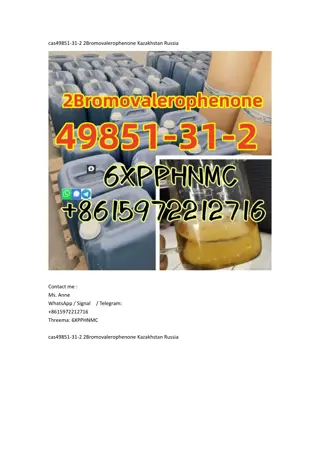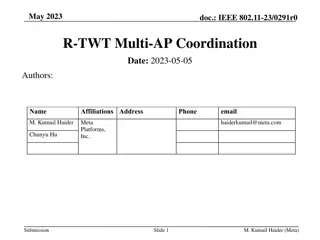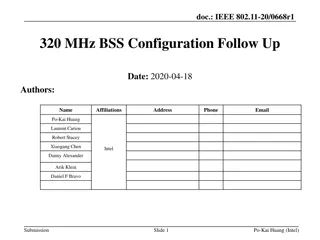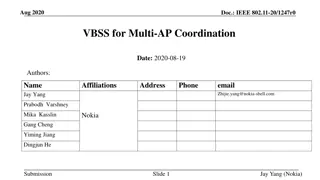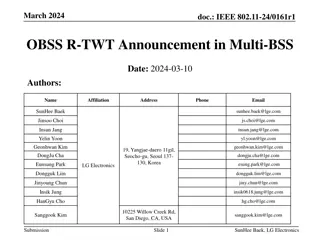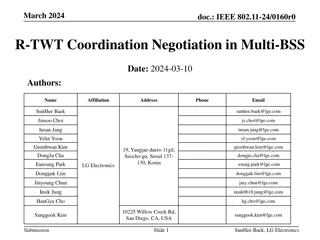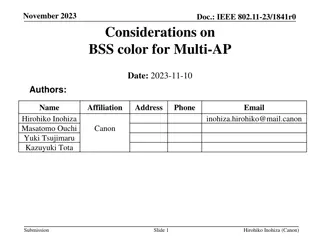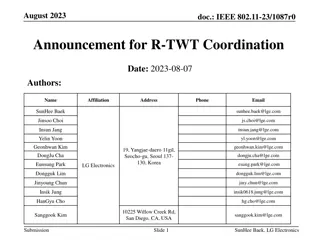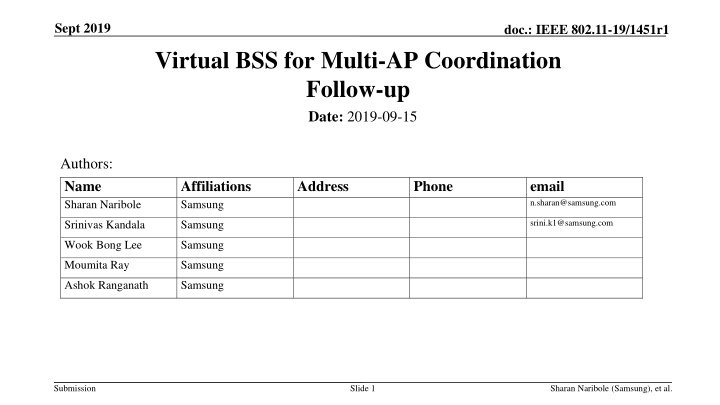
IEEE 802.11-19/1451r1 Multi-AP Coordination Discussion
Delve into the world of multi-AP coordination as discussed in the IEEE 802.11-19/1451r1 document. Explore topics such as virtual BSS, joint processing, coordinated beamforming, and more. Understand the requirements for seamless frame exchange, simultaneous connectivity, and secure connections between STAs and coordinating APs. Discover insights on authentication, association, network discovery, and mobility domain protocols within the realm of wireless connectivity.
Download Presentation

Please find below an Image/Link to download the presentation.
The content on the website is provided AS IS for your information and personal use only. It may not be sold, licensed, or shared on other websites without obtaining consent from the author. If you encounter any issues during the download, it is possible that the publisher has removed the file from their server.
You are allowed to download the files provided on this website for personal or commercial use, subject to the condition that they are used lawfully. All files are the property of their respective owners.
The content on the website is provided AS IS for your information and personal use only. It may not be sold, licensed, or shared on other websites without obtaining consent from the author.
E N D
Presentation Transcript
Sept 2019 doc.: IEEE 802.11-19/1451r1 Virtual BSS for Multi-AP Coordination Follow-up Date: 2019-09-15 Authors: Name Sharan Naribole Affiliations Samsung Address Phone email n.sharan@samsung.com srini.k1@samsung.com Srinivas Kandala Samsung Wook Bong Lee Samsung Moumita Ray Samsung Ashok Ranganath Samsung Submission Slide 1 Sharan Naribole (Samsung), et al.
Sept 2019 doc.: IEEE 802.11-19/1451r1 TGbe Multi-AP Coordination Multi-AP Coordination is a candidate feature being discussed in TGbe group There are many categories of multi-AP coordination including joint processing, coordinate OFDMA, null forming, coordinated beamforming, AP selection, etc. In both downlink and uplink, the AP(s) used may vary dynamically based on link quality, load balancing, etc. [1][2][3][4] Submission Slide 2 Sharan Naribole (Samsung), et al.
Sept 2019 doc.: IEEE 802.11-19/1451r1 Multi-AP Coordination Requirements Seamless exchange of frames between STA and coordinating APs without negotiation overhead o Simultaneous connectivity with multiple APs Secure connection between STA and coordinating APs o Single authentication and association state o Encryption for different flavors of multi-AP transmission In this presentation, we focus on the authentication and association Submission Slide 3 Sharan Naribole (Samsung), et al.
Sept 2019 doc.: IEEE 802.11-19/1451r1 802.11 Authentication Recap Network discovery 802.11 open authentication 802.11 association 802.1X/SAE/FILS authentication o Skipped if pre-shared keys o Master session key generated o Master keys for unicast (PMK) and group addressed (GMK) frames at AP and STA 4-way handshake o AP and STA confirm they have same PMK o Temporal keys generated (PTK, GTK, IGTK) Submission Slide 4 Sharan Naribole (Samsung), et al.
Sept 2019 doc.: IEEE 802.11-19/1451r1 802.11r Mobility Domain Recap (1/2) Protocols for reducing security overhead in roaming Assumes WLAN Controller securely connected to APs Full authentication performed at initial association with mobility domain Fast BSS transition (FT) key hierarchy o PMK-RO at WLAN controller, separate PMK for each AP WLAN Controller WLAN Controller AP 1 AP 2 Mobility Domain AP 1 AP 2 STA Submission Slide 5 Sharan Naribole (Samsung), et al.
Sept 2019 doc.: IEEE 802.11-19/1451r1 802.11r Mobility Domain Recap (2/2) Full authentication during initial association with mobility domain o PMK-RO generation at WLAN controller o PMK-R1s derived and distributed to APs 4-way handshake o Temporal keys generated with only the associated AP Fast transition protocols o 802.11 authentication frames enriched with new IEs o Temporal keys generated with target AP Is 802.11r sufficient for EHT Multi-AP? o No simultaneous connection to multiple APs o However, we can extend/re-use FT protocols Submission Slide 6 Sharan Naribole (Samsung), et al.
Sept 2019 doc.: IEEE 802.11-19/1451r1 Virtual BSS Infrastructure BSS with a group of APs coordinated by V-BSS coordinator Seamless transmission of data frames to and from multiple APs Presented in July meeting [3] Dynamic AP selection by STA and V-BSS Coordinator Transparent data reception Single association and authentication state maintenance Focus of this presentation Submission Slide 7 Sharan Naribole (Samsung), et al.
Sept 2019 doc.: IEEE 802.11-19/1451r1 Virtual BSS Initial Association Virtual BSS operation advertised in Beacons, Probe Response, (Re) Assoc Response Open authentication and association performed with a specific AP of Virtual BSS o Association Request indicates request to join the Virtual BSS Association Response includes V-BSS Coordinator key holder ID o Used to generate PMK at STA and V-BSS Coordinator similar to 802.11r PMK-R0 Temporal key generation depends on the Virtual BSS architecture o Partition of functionalities between the V-BSS Coordinator and APs Virtual BSS Authentication modes o Option 1: Temporal key generation with V-BSS Coordinator o Option 2: Temporal key generation with individual APs Selected mode needs to be indicated to STAs joining the Virtual BSS o Example: Association Response Submission Slide 8 Sharan Naribole (Samsung), et al.
Sept 2019 doc.: IEEE 802.11-19/1451r1 Option 1: Temporal Key generation with V-BSS Coordinator Temporal keys generated between STA and V-BSS Coordinator using PMK-Coordinator V-BSS Coordinator performs data encryption and decryption APs serve as a relay forwarding packets to and from V-BSS coordinator and STA Derives PTK Submission Slide 9 Sharan Naribole (Samsung), et al.
Sept 2019 doc.: IEEE 802.11-19/1451r1 Option 2: Temporal Key generation with individual APs PMK-AP derived from PMK-Coordinator and distributed by V-BSS Coordinator to APs STA can generate temporal keys with multiple APs of Virtual BSS o 802.11r protocols can be extended for the key generation with the individual APs Separate keys maintained for each AP o Corresponding keys used for communication between STA and AP Dynamic AP selection limited to the subset with whom temporal keys are generated Submission Slide 10 Sharan Naribole (Samsung), et al.
Sept 2019 doc.: IEEE 802.11-19/1451r1 Multi-AP Coordination Capability Category Temporal keys with V-BSS Coordinator Temporal keys with individual APs Coordinated OFDMA Coordinated Beamforming Null Forming Joint AP Transmission X In joint AP transmission, multiple APs transmit exact same data to STA Submission Slide 11 Sharan Naribole (Samsung), et al.
Sept 2019 doc.: IEEE 802.11-19/1451r1 Further Consideration Security assessment of Virtual BSS Authentication modes Addressing for transparent data reception Secure channel between the V-BSS Coordinator and APs Data flow between the STA and Virtual BSS Submission Slide 12 Sharan Naribole (Samsung), et al.
Sept 2019 doc.: IEEE 802.11-19/1451r1 Summary To achieve seamless transmission of frames between STAs and APs participating in Multi-AP Coordination, security framework needs important consideration Presented Virtual BSS association protocol Depending on Virtual BSS architecture partition, temporal key generation can be performed directly with V-BSS Coordinator or with individual APs Submission Slide 13 Sharan Naribole (Samsung), et al.
Sept 2019 doc.: IEEE 802.11-19/1451r1 References [1] 11-19/1019, Virtual BSS for Multi AP Coordination [2] 11-19/0089, Distributed MU-MIMO Architecture Design Considerations [3] 11-19/0804, Multi-AP Transmission Procedure [4] 11-19/1129, Consideration on Multi-AP Coordination Submission Slide 14 Sharan Naribole (Samsung), et al.




